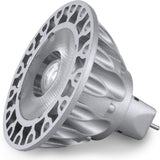Guide to Beam Metrics for Comparing LED to Halogen Directional Bulbs
Posted by Dave on for ProLampSales

LED light is inherently directional.
Most traditional light sources - incandescent, halogen, compact fluorescent and HID - emit light in all directions.
For these light sources to have specific directional characteristics, the lamp is made with a reflector and sometimes a lens to modify the illumination so it becomes more focused, or directional.
For example, PAR halogen lamps are available in a range of beam angles from 60°, a wide flood, to 8° a narrow spot. The light bulbs use parabolic reflectors (PAR) to direct the light into specific beam distributions.
Much of the initial penetration of LED lamps in the market was as replacements for PAR halogen lamps. The directional nature of the LED light source made them a natural replacement lamp for halogen PAR. However, some PAR applications require more precision than others in beam characteristics.
This post will focus on the metrics that describe beams from directional light bulbs – specifically how to compare the beam of a halogen lamp to that an LED lamp so you end up with a more energy efficient, longer life light source that reproduces, as closely as possible, the illumination provided by halogen.
Beam Spread
Flood, Narrow Flood, Wide Flood and Spot are common designations used by manufacturers for beam spread. Beam spread terminology is subjective. What is a flood to one person may be a narrow flood to another. Even lamp manufacturers will disagree, giving light bulbs with the same beam angle different beam spread designations.
However, matching the beam spread designation used by the halogen lamp manufacturer with the LED manufacturer will provide a useful comparison for many general flood lighting applications.
For lighting installations in art galleries, museums, and similar spaces where the beam must be well defined and accurate, a beam spread designation such as 'narrow flood' or 'spot' will not provide enough information. Instead, the beam angle provided by the manufacturer should be used.
Beam Angle
Beam angles of 12°, 25°, 35° and higher are often listed in the specification sheets provided by both halogen and LED manufacturers. The beam angle gives a more precise understanding of the beam than the beam spread. Here is a table of the usual ranges of beam angles associated with beam spread designations. Note the considerable range of angles within a typical beam spread designation. This illustrates how for certain types of directional lighting, particularly narrow beam accent lighting where beam accuracy is important, there is no substitute for knowing the precise beam angle of a lamp.
- 8° - 15° = Spot
- 20° - 35° = Narrow Flood
- 35° - 55° = Flood
- 60° and greater = Wide Flood
Center Beam Candlepower (cd)
Center beam candlepower, measured in candelas (cd), indicates the lumen intensity of the light at its most intense point. It becomes more important as the beam angle narrows. Arguably it is the most important metric for spot accent light applications. Unfortunately it is the one value that is sometimes missing from LED lamp manufacturer specification sheets. Here is an example of center beam candlepower values from a family of MR16 halogen lamps from one manufacturer.
- 12° Spot: 8000 cd
- 25° Narrow flood: 2000 cd
- 35° Flood: 1000 cd
- 60° Wide Flood: 500 cd
The cd values for different beam angles are not always the same. There can be considerable variation within a specific beam angle. The key is to be able to compare the center beam candlepower for a halogen lamp with a 12° beam angle to that of a 12° beam angle LED lamp. For narrow spot beam applications the most important comparative metric between different lamps is center beam candlepower.
Lumens
While lumen output is often the key specification that will indicate a match between halogen and LED lamps, in the case of PAR and MR lamps, lumens are most useful when comparing wider beam floods. As the beam narrows, center beam candlepower becomes the primary metric for comparison.
In summary, when you are considering a replacement of directional halogen with LED it's important to understand which of the light metrics discussed in this post are most important in determining the match for your application.
General floodlighting with PAR lamps requires only beam spread and lumens to get a reasonable match between halogen and LED.
Narrow beam accent lighting commonly used to illuminate art work and for other specific accent lighting applications requires matching LED center beam candlepower (cp) and beam angle values with the existing halogen lamps.
In all cases, color temperature and color rendering are also important metrics to include in the comparative analysis.
In cases where beam distribution is critical, photometric files and polar graphs, should be obtained from the manufacturers so precise comparisons can be made between products. This may require utilizing a lighting professional.
Note: Special care must be taken when replacing MR16 halogen with MR16 LED. Aside from the metrics discussed in this post, unique characteristics of MR16 halogen have made them perhaps the most challenging of all common light sources to replicate with LED. For more on this issue read this blog post.
Featured Products (View All)
0 Comments




